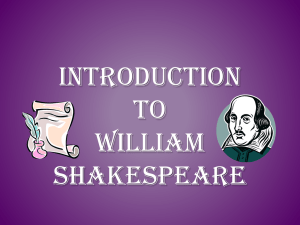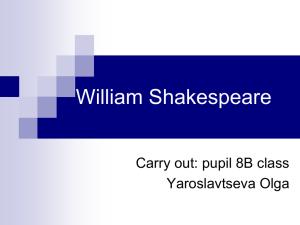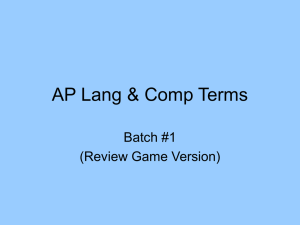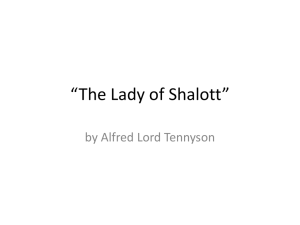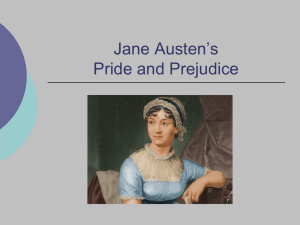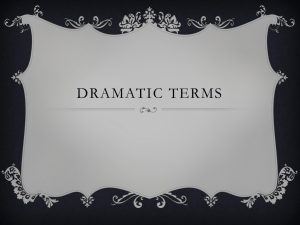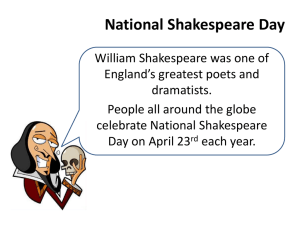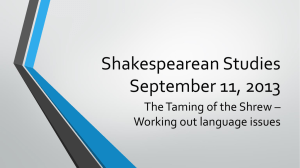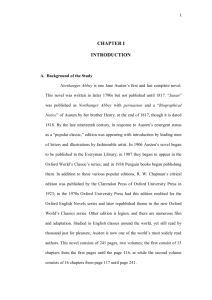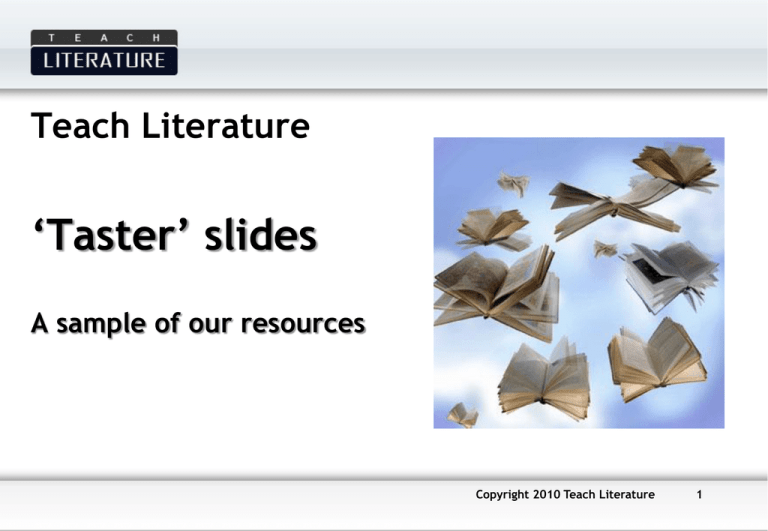
Teach Literature
‘Taster’ slides
A sample of our resources
Copyright 2010 Teach Literature
1
Teach Literature
• Save yourself hours of planning and
research
• High quality teaching resources
designed to stimulate discussion and
independent thinking
• Accessing all Assessment Objectives for
AQA(A), AQA(B), OCR, EDEXEL, WJEC
• Can be used as complete schemes of
work
• Printable worksheets for homework,
extension and exam preparation
• An ideal resource for new teachers to
guide them through the delivery of a
text
Copyright 2010 Teach Literature
2
Genre: Novels
Copyright 2010 Teach Literature
3
Teaching
Pride and
Prejudice
Jane Austen
Copyright 2010 Teach Literature
4
Chapter 13
Task:
Annotate the following description of Mr Collins’ arrival
at the Bennet family home. Write how effective Austen’s
use of language and structure is in conveying her opinion
of Mr Collins in this chapter.
“Mr Collins was punctual to his time, and was received with great
politeness by the whole family. Mr Bennet, indeed, said little; but
the ladies were ready enough to talk, and Mr Collins seemed
neither to need encouragement, nor inclined to be silent himself.
He was a very tall, heavy looking young man of five and twenty. His
air was grave and stately, and his manners were very formal. He
had not been long seated before he complimented Mrs Bennet on
having so fine a family of daughters, said he had heard much of
their beauty, but that, in this instance, fame had fallen short of
truth; and added, that he did not doubt seeing them all in due time
well disposed of in marriage. This gallantry was not much to the
taste of some of his hearers, but Mrs Bennet who quarrelled not
with compliments, answered most readily.
Copyright 2010 Teach Literature
5
Teaching
The Kite Runner
Khalid Hosseini
Analysis of Chapters 15 & 16
What happens
How Hosseini tells quote
the story
He describes how he
was welcomed into
Hassan’s family home
He tells how, during
his stay, Sanubar
returns
Hassan and Farzana
have a son, Sohrab
Effect on reader
‘There was nothing in
the room, just a frayed
rug, a few dishes, a pair
of mattresses and a
lantern.’
Simple, positive
descriptions of the child
1995 – conflict returns Brutal, blunt
to
descriptions of the
violence and brutality
He describes Sohrab’s Symbolism of the kite
skill with the kite
‘Hassan would prop
Sohrab on his shoulders
and they would go
trotting through the
streets, running kites…’
Language indicates
Hassan’s pride in his son
‘they would put them up
like paintings’
Copyright 2010 Teach Literature
7
Teaching
Enduring Love
Ian McEwan
Copyright 2010 Teach Literature
8
Understanding context: research task
Individually carry out independent
research into:
De Clerambault’s syndrome:
What is it?
What is the history of this illness?
Keats and the romantics:
What did the romantics believe about
art and life?
Science and rationalism:
What does evolutionary science tell us
about love?
Copyright 2010 Teach Literature
9
Teaching
Frankenstein
Mary Shelley
Copyright 2010 Teach Literature
10
Letters I – IV: narrative frame
Shelley chooses to introduce her
narrative by way of a framed
narrator in the form of Walton. She
uses the epistolary form here
Exploring the beginning of
the narrative:
What elements of the Gothic can you see
in this section?
What is the effect of using Walton as
narrator?
Why does Shelley choose to use epistles
here?
To what extent do you think Walton can
be described as a foil?
How does Shelley use place and nature
to create a specific atmosphere ?
How is our vision of both Victor and the
Creature affected by this form of
introduction?
Teaching
The Great Gatsby
F Scott Fitzgerald
Copyright 2010 Teach Literature
12
Brief History of Fitzgerald
Family Background
Both parents were Catholics.Although there were periods of financial
struggle the money his mother inherited enabled them to live comfortably .
Education
Fitzgerald attended St. Paul Academy and started writing for a school
magazine, he began to write short stories and plays . He was moved to The
Newman School,a Catholic school in New Jersey.
He went on to study at Princeton University where his involvement in
developing his own writing affected his academic studies .
Early Adult Life
In May 1917 Fitzgerald left Princeton and enlisted in the army to fight in
World War 1. He was sent to Camp Sheridan in Alabama for officer training.
It was during this period he met Zelda Sayre, he fell madly in love with her
but and she had no intentions of marrying him until her was a financial
success.
Fitzgerald began working on his novel, "This Side of Paradise"and when it
was published in March of 1920 it was well received. He quickly began a
successful and with that came the wealth that he so desired.
Zelda Sayre now agreed to marry him and they moved to an apartment in
New York where he began writing on his second novel " The Beautiful and
the Damned" They had a daughter ,Francis, in 1921.
Copyright 2010 Teach Literature
13
Teaching
Northanger Abbey
Jane Austen
Copyright 2010 Teach Literature
14
Volume Two - chapter 20
Catherine is delighted to be given the opportunity to sit beside
Henry Tilney on their route to Northanger Abbey. Henry is well
aware of Catherine’s love of “Horrid tales..” and very
graphically describes her version of the events she will
encounter when she arrives at Northanger Abbey…..
In Groups
Carefully read aloud the passages where Henry dramatises his
hypothetical tale of Catherine’s first night at Northanger
Abbey. Look closely at how Jane Austen uses form, structure
and language to convey meanings.
What were Catherine’s first impressions of the abbey and what
Is the effect of her disappointment?
Essay Writing.
Plan and write a insightful response to the following :
“Chapter 20 is an elaborate parody of the conventions of
Gothic novels and is filled with references to actual novels”
How far do you think this is an accurate comment ?
Copyright 2010 Teach Literature
15
Genre: Poetry
Copyright 2010 Teach Literature
16
Teaching
WILFRED OWEN
Selected poems
Copyright 2010 Teach Literature
17
‘Strange Meeting’
Owen takes his reader on a journey, through the tunnels and holes that not only
represent the present of a first world war dug-out but the entrance to Tartarus, the
underworld where, in Greek Mythology, the Titans were chained as punishment for
losing their fight with Zeus. Owen meets “ the enemy you killed.” Their greeting’
“Strange friend,” I said, “he is no cause to mourn” “None,” said that other, “ save
the undone years, the hopelessness” This refers directly to a scene in the Iliad
where two warriors, on opposite sides of the war, talk and realise their shared
connections as humans is far more meaningful than the hostility of war. They then
swap their armour and part peacefully.
Answer the following questions :
1.
2.
3.
4.
5.
6.
7.
8.
What does the “thousand pains” refer to ?
Why does the narrator introduce their one-sided dialogue with a paradox “strange friend”?
What ‘shared purpose’ does the German soldier describe ?
What effect does the line “ The pity of war, the pity war distilled” have on
the mood of the poem?
What impact does sibilance have on the line “be swift with swiftness of the
tigress”?
What is significant about the human attributes of ‘courage’, ‘mystery’,
‘wisdom’ and ‘mastery’ in this context ?
In what way does the “my friend” contrast to the bitterly ironic “my
friend” of ‘Dulce et decorum est’ ?
What does the final line “Let us sleep now…” suggest to the reader ?
Teaching
John Keats
Selected poems
Copyright 2010 Teach Literature
19
Revision quiz
1.
2.
3.
4.
5.
6.
7.
8.
9.
10.
11.
12.
13.
14.
15.
Who ‘limped trembling through the frozen grass’?
Who is the ‘patient, holy man’?
Complete this extract:
His prayer he saith, this _______, holy man;
Then takes his lamp, and riseth from his_______,
And back returneth, ________barefoot, wan,
What is the ‘prelude soft’?
What yearned ‘like a God in pain’ and why?
Who are the ‘blood thirsty race’?
Complete this couplet:
He found him in a little moonlight ________,
Pale, lattic’d, chill, and silent as a ________
Why does Porphyro look like a ‘puzzled urchin’?
Name three of the foods that Porphyro lays out for Madeline
What pictures feature on the stained glass window in Madeline’s bedroom?
What instrument does Porphyro play? What song does he play?
Who says: “For if thou diest, my Love, I know not where to go.” ?
Complete this extract:
At these __________accents, he arose,
Ethereal, flush’d, and like a __________star
Where does Pophyro say his home is?
What kind of dog is guarding the door?
Copyright 2010 Teach Literature
20
Teaching
‘Sonnets from the
Portuguese’
Elizabeth Barrett
Browning
Copyright 2010 Teach Literature
21
Sonnets from the Portuguese
The sonnets can be divided into four thematic ‘clusters’:
sonnets
I – IX (1-9)
The poet describes her personal
situation and fears she is not
worthy to love Browning
X-XXI (10-21)
The poet realises the value of love
and her confidence grows
XXII-XL (22-40)
The poet’s increasing trust in the
power of love and a total
declaration of affection for
Browning
XLI-XLIV (41-44)
The poet examines the
transforming power of love and
dedicates herself to Browning
Copyright 2010 Teach Literature
22
Teaching
Alfred, Lord Tennyson
Selected poems
Copyright 2010 Teach Literature
23
Pre-Raphaelite illustrations of ‘The Lady of Shalott’
“The Lady of Shalott”
By William Maw Edley
(1858)
“The Lady of Shalott
By William Holman Hunt
(1886-1905)
“I am half sick of shadows
Said the Lady of Shalott”
By John W. Waterhouse
(1915)
“The Lady of Shalott”
By John W. Waterhouse
(1894)
Copyright 2010 Teach Literature
24
Genre: Drama
Copyright 2010 Teach Literature
25
Teaching
Hamlet
Copyright 2010 Teach Literature
26
Context: Revenge Tragedy
Roman playwright Lucius Seneca (4 B.C. – 65 A.D.) set the basic pattern for
the Elizabethan revenge tragedy.‘Tragedy of blood’ became popular among
audiences at the end of the 16th Century. As a commercial playwright,
Shakespeare and his company needed to respond to popular trends.
Shakespeare adopted the traditional five part structure: Exposition of events
in the past requiring vengeance, Anticipation, usually detailed planning of
revenge, Confrontation between avenger and victim, Partial Execution of the
avenger’s plan, Completion of the act of vengeance.
The following elements were among those frequently present in drama
influenced by Seneca’s works: a secret murder, a ghostly visitation, a period
of disguise, intrigue and scheming by avenger and murderer, an avenger who
ruthlessly pursues revenge, meditative soliloquy, eruption of violence at the
end. In ‘Hamlet’ Shakespeare added psychological depth, a more complex plot
and a fairly unusual tragic hero.
Copyright 2010 Teach Literature
27
Teaching
The White Devil
John Webster
Copyright 2010 Teach Literature
28
Act IV scene iii
In this scene, Monticelso has been selected as the new
Pope (Pope Paul IV). He immediately excommunicates
Brachiano and Vittoria who have fled the city.
Francisco instructs Lodovico to carry out the murder of
Brachiano. Monticelso warns him against committing
murder ‘tis damnable’ and he changes his mind ‘I’ll
give it o’er’ but then he receives money from
Francisco and, believing that it was sent by the Pope,
resolves to carry out the murder, ‘Now to the act of
blood.’
1. Why does Monticelso advise Lodovico not to
murder Brachiano when he was active in prompting
Francisco to revenge in Act IV scene i?
2. What is the significance of Lodovico’s speech at the
end of the scene?
How is the Church portrayed
in this scene? How might this
have been received by a
Jacobean audience?
Copyright 2010 Teach Literature
29
Teaching
The Winter’s Tale
William Shakespeare
Copyright 2010 Teach Literature
30
Context: Who was king? What was the role of the king
at the time?
What would James I have made of ‘The Winter’s Tale’ “a play about a monarch whose
dogged adherence to James’s deepest convictions about the independence, indeed
the sanctity of the royal judgement brings him to the edge of tragedy”? (Orgel 1996)
It couldn’t have offended him – he paid the players to perform it repeatedly for
his entertainment at court
Perhaps he considered it merely a fable / tragicomedy?
Perhaps he saw that the message was: however bad a king is, he is still the king?
Questions to consider as you work through the play:
1. What issues about kingship are raised by Paulina and the lords in Act I?
2. King James I is described here as ‘withdrawn, uncharismatic and
authoritarian’. What aspects of Leontes may compare with this
description? Do you think Shakespeare intended him to be similar or
different to James I?
3. What do you think James I would have made of this play? What is the
more likely explanation?
4. What does Paulina have to say about royal marriage in Act V scene i?
Summarise using quotes from the play
5. What do you think Shakespeare is saying about the divine power of
kingship in this play?
Copyright 2010 Teach Literature
31
Teaching
All My Sons
Arthur Miller
Copyright 2010 Teach Literature
32
Language
Key feature
Example from text
analysis
Stage directions to
direct action
Stage directions to guide
expression
Features of real
conversation
Speeches of varied
length
Question / exclamation /
command / statement
Repetition / reiteration
Idiolect: what are the
distinctive features of
each characters’ language
which reveal aspects of
their personality, motives,
feelings?
Copyright 2010 Teach Literature
33
General resources
Copyright 2010 Teach Literature
34
Teaching
Gothic Literature
An introduction
Copyright 2010 Teach Literature
35
Characteristic features of gothic literature
Abbeys / monasteries
Embedded
narratives
Threat (anticipated,
perceived or real)
Ancestral curses
Forests
Persecution
Blood
Ghosts & hauntings
Mystery & obscurity
Castles & Dungeons
Labyrinths &
mirrors
Wild, remote
landscapes
Catholic or feudal
society
Incest & insanity
Escape / escape
denied
Corruption
Monks & monsters
Violence / violation
Crypts / cloisters
Multiple narrative
voices
Vampires
Death
Hyperbolic language
Torture
Doppelganger
Sensational /
shocking events
Sex
Dreams
Forbidden
knowledge
Oppression
Storms
Trespass
Revenge
Copyright 2010 Teach Literature
36
Teaching
NARRATIVE METHODS
Exploring the techniques used
by writers in order to construct
meaningful and satisfying
narratives
Copyright 2010 Teach Literature
37
How characters are made.
Writers have at their disposal several interesting and effective ways of
creating characters. The central techniques in conventional literature are:
Use of dialogue
Narrative intervention/evaluation
Appearance
Other characters’ opinions of
them
Their actions
What they do or don’t say
Their name
Any setting associated with them
Diction associated with them
Images associated with them.
In groups explore in depth the way in which a specific character has
been constructed and the effect it has on readers’ appreciation of this
character’s personality, role and function in the narrative.
Copyright 2010 Teach Literature
38


